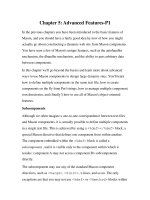Chapter 5 Methods
Bạn đang xem bản rút gọn của tài liệu. Xem và tải ngay bản đầy đủ của tài liệu tại đây (378.66 KB, 79 trang )
Chapter 5
Methods
Contents
1. Introduction to Methods
2. Passing Arguments to a Method
3. More about Local Variables
4. Returning a Value from a Method
5. Problem Solving with Methods
2
1. Introduction to Methods
A method is a collection of statements that
performs a specific task.
We have experienced methods in two ways:
Creating a method named main in every program
Using predefined methods from the Java API,
such as
System.out.println
Integer.parseInt
Math.pow
3
1. Introduction to Methods
Methods are commonly used to break a problem
into small manageable pieces.
Instead of writing one long method that contains
all of the statements, several small methods that
each solve a specific part of the problem can be
written.
This approach is called divide and conquer
because a large problem is divided into several
problems.
4
1. Introduction to Methods
public class BigProblem
{
public static void main(String[]
args)
{
statement;
statement;
statement;
statement;
statement;
statement;
statement;
statement;
statement;
statement;
statement;
statement;
statement;
statement;
statement;
statement;
statement;
}
}
public class DividedProblem
{
public static void main(String[]
args)
{
statement;
statement;
statement;
}
public static void method2()
{
statement;
statement;
statement;
}
public static void method3()
{
statement;
statement;
statement;
}
public static void method4()
{
statement;
5
1. Introduction to Methods
Another reason to write methods is that they
simplify programs.
If a specific task is performed in several places in
a program, a method can be written once and
then be executed anytime it is needed.
This benefit of using methods is known as code
reuse.
6
void Methods and ValueReturning Methods
Two general categories of methods:
void methods
Value-returning methods
A void method performs a task and then
This method displays the value on
terminates.
the screen, and then terminates.
int number = 7;
System.out.println(number);
number = 0;
7
void Methods and ValueReturning Methods
A value-returning methods not only performs a
task, but also sends a value back to the code that
called it.
int number;
String str = “700”;
number = Integer.parseInt(str);
This method converts the string to a number,
and then returns the number to this line of code.
8
Defining a void Method
To create a method we must write its definition,
which consists of two general parts:
A header
Appears at the beginning of a method definition
Header
public static void main(String[] args)
Lists several important
things
about
the
method
{
Body
Method Modifiers}
System.out.println(“Hello World!”);
Return type
Method's name
Arguments
9
Defining a void Method
Return Type
Method Modifiers
Method Name
Parentheses
public static
void
displayMessage ()
{
The method header is never te
System.out.println(“Hello from the displayMessage method.”);
}
Method Modifiers:
- public: The method is publicly available to code outside the class
- static: The method belongs to the class, not a specific object.
Return Type:
- void: The method is a void method, and does not return a value.
Method Name: A descriptive name that can describes the function of the method.
Parentheses:
- The method name is always followed by a set of parentheses.
10
Calling a Method
A method executes when it is called.
The main method is automatically called when a
program starts.
Other methods are executed by method call
statements.
When a method is called, the JVM branches to
that method and executes the statements in its
body.
Method call statement:
- The statement is simply the name of the method followed by a set of parentheses.
- The method modifiers and the void return type are not written.
displayMessage();
11
Calling a Method
12
Branching in the
SimpleMethod.java Program
public static void main(String[] args)
{
System.out.println("Hello from the main method.");
displayMessage();
System.out.println("Back in the main method.");
}
public static void displayMessage()
{
System.out.println("Hello from the displayMessage method.");
}
13
Calling a Method
14
Calling a Method
Problem: Write a program to ask the user to enter
his annual salary and credit rating. The program
determines whether the user qualifies for a credit
card. One of two void methods, qualify or
noQualify, is called to display a message.
Credit rating:
1 (very bad) through 10 (excellent)
The user qualifies for a credit card if his salary is
not less than $20,000 and his credit rating is not
15
less than 7.
Calling a Method
16
Calling a Method
17
Checkpoint
5.1
5.2
5.3
5.4
5.5
18
Hierarchical Method Calls
Methods can also called in a hierarchical, or
layered fashion.
Method A can call method B, which can call
method C.
When method C finishes, the JVM returns to
method B.
When method B finishes, the JVM returns to
method A.
19
Hierarchical Method Calls
20
Using Documentation Comments
with Methods
You should always document a method by writing
comments that appear just before the method's
definition.
The comment should provide a brief explanation
of the method's purpose.
Recall that documentation comments begin
with /** and end with */. These types of
comments can be read and processed by a
program named javadoc which produces
attractive HTML documentation.
21
2. Passing Arguments to a
Method
Values that are sent into a method are called
arguments.
System.out.println(“Hello World!”);
This call statement passes “Hello World!” as
an argument.
number = Integer.parseInt(str);
This call statement passes the contents of the
str variable as an argument.
22
2. Passing Arguments to a
Method
A parameter variable, sometimes simply referred
to as a parameter, is a special variable that holds
a value being passed into a method.
public static void displayValue(int num)
{
System.out.println(“The value is “ + num);
}
int num
declaration of an parameter variable
23
enables the displayValue method to accept an
2. Passing Arguments to a
Method
public static void displayValue(int num)
{
System.out.println(“The value is “ + num);
}
A call to the displayValue
The argument 5 is copied into
the parameter variable num.
displayValue(5);
This statement executes the displayValue
method.
Statements call the displayValue method with
24
various arguments passed:
2. Passing Arguments to a
Method
25









